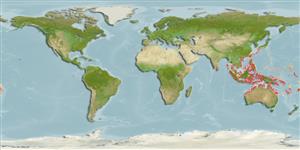Actinopterygii (ray-finned fishes) >
Perciformes (Perch-likes) >
Pseudochromidae (Dottybacks) > Congrogadinae
Etymology: Congrogadus: Latin, conger = conger + Latin, gadus = a fish, perhaps cod (Ref. 45335).
Environment / Climate / Range
Ecology
Marine; brackish; reef-associated; depth range 0 - 10 m (Ref. 90102). Tropical, preferred ?; 35°N - 25°S
Indo-West Pacific: Nicobar Islands, Andaman Sea and Japan to the tropical coasts of Australia.
Length at first maturity / Size / Weight / Age
Maturity: Lm ?, range 20 - ? cm
Max length : 45.0 cm TL male/unsexed; (Ref. 3132)
Dorsal
spines
(total): 0;
Dorsal
soft rays
(total): 68-74;
Anal
spines: 0;
Anal
soft rays: 57 - 66;
Vertebrae: 74 - 84. Coloration varied, capable of changing its color. Spots or blotches on body form reticulations and crossbands; paler ventrally. Gill membranes ventrally free from the isthmus. Posterior otic sensory canal pore present. Cephalic sensory canal pores not pigmented.
Inhabits coastal waters, often in brackish conditions (Ref. 48636). Found hidden amongst rocks or coral rubble (Ref. 48636). Reproductive activity appears to be cyclical and the species may not be a protogynous hermaphrodite (Ref. 2077). Also found in coral reefs among crevices (Ref 90102).
Life cycle and mating behavior
Maturity | Reproduction | Spawning | Eggs | Fecundity | Larvae
Winterbottom, R., 1985. Revision and vicariance biogeography of the subfamily Congrogadidae (Pisces: Perciformes: Pseudochromidae). Indo-Pac. Fish. (9):34 p. (Ref. 531)
IUCN Red List Status (Ref. 115185)
CITES (Ref. 94142)
Not Evaluated
Threat to humans
Harmless
Human uses
Aquarium: commercial
More information
ReferencesAquacultureAquaculture profileStrainsGeneticsAllele frequenciesHeritabilityDiseasesProcessingMass conversion
Tools
Special reports
Download XML
Internet sources
